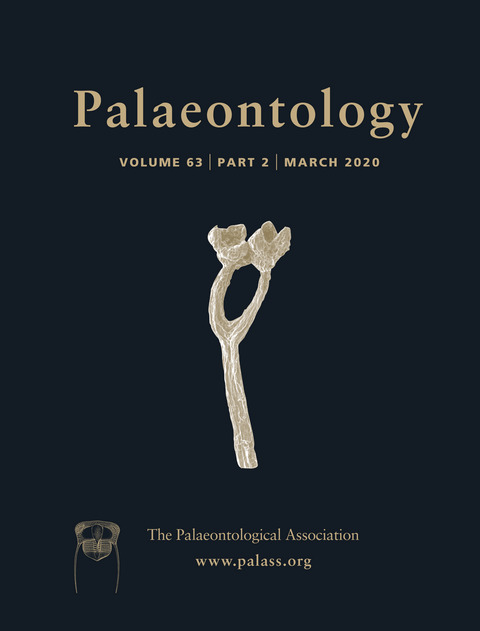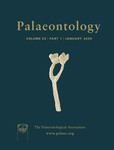Volume 63 | Part 3
Publication: Palaeontology
Volume: 63
Part: 3
Publication Date: May 2020
Page(s): 459–475.
DOI: 10.1111/pala.12466
Authored By: Marta Pina, Daniel DeMiguel, Francesc Puigvert, Jordi Marcé‐Nogué, and Salvador Moyà‐Solà
Publication: Palaeontology
Volume: 63
Part: 3
Publication Date: May 2020
Page(s): 477–495.
DOI: 10.1111/pala.12467
Authored By: Damián E. Pérez, and Luciana M. Giachetti
Publication: Palaeontology
Volume: 63
Part: 3
Publication Date: May 2020
Page(s): 497–512.
DOI: 10.1111/pala.12468
Authored By: Adán Pérez‐García, Evangelos Vlachos, and Xabier Murelaga
Abstract
|
Get Article:
Wiley Online Library
[Pay-to-View Access] |
Members: Login for Free Access
Publication: Palaeontology
Volume: 63
Part: 3
Publication Date: May 2020
Page(s): 513–524.
DOI: 10.1111/pala.12474
Authored By: Jennifer F. Hoyal Cuthill, and Aaron W. Hunter
Volume 63 | Part 2
Publication: Palaeontology
Volume: 63
Part: 2
Publication Date: March 2020
Page(s): 185–193.
DOI: 10.1111/pala.12470
Authored By: Matteo Fabbri, Jasmina Wiemann, Fabio Manucci, and Derek E. G. Briggs
Publication: Palaeontology
Volume: 63
Part: 2
Publication Date: March 2020
Page(s): 195–202.
DOI: 10.1111/pala.12469
Authored By: Suryendu Dutta, Sumit Kumar, Hukam Singh, Mahasin A. Khan, Amlan Barai, Anuradha Tewari, Rajendra S. Rana, Subir Bera, Shamik Sen, and Ashok Sahni
Publication: Palaeontology
Volume: 63
Part: 2
Publication Date: March 2020
Page(s): 203–228.
DOI: 10.1111/pala.12449
Authored By: Jens N. Lallensack, Thomas Engler, and H. JONAS Barthel
Publication: Palaeontology
Volume: 63
Part: 2
Publication Date: March 2020
Page(s): 229–242.
DOI: 10.1111/pala.12451
Authored By: Kimberley E. J. Chapelle, Roger B. J. Benson, Josef Stiegler, Alejandro Otero, Qi Zhao, and Jonah N. Choiniere
Publication: Palaeontology
Volume: 63
Part: 2
Publication Date: March 2020
Page(s): 243–253.
DOI: 10.1111/pala.12452
Authored By: James Saulsbury, and Samuel Zamora
Publication: Palaeontology
Volume: 63
Part: 2
Publication Date: March 2020
Page(s): 255–282.
DOI: 10.1111/pala.12454
Authored By: Emily E. Brown, Richard J. Butler, Martín D. Ezcurra, Bhart‐Anjan S. Bhullar, and Stephan Lautenschlager
Publication: Palaeontology
Volume: 63
Part: 2
Publication Date: March 2020
Page(s): 283–299.
DOI: 10.1111/pala.12455
Authored By: Joep Schaeffer, Michael J. Benton, Emily J. Rayfield, and Thomas L. Stubbs
Publication: Palaeontology
Volume: 63
Part: 2
Publication Date: March 2020
Page(s): 301–312.
DOI: 10.1111/pala.12457
Authored By: Isabelle Kruta, Jérémie Bardin, Christopher P. A. Smith, Paul Tafforeau, and Neil H. Landman
Publication: Palaeontology
Volume: 63
Part: 2
Publication Date: March 2020
Page(s): 313–329.
DOI: 10.1111/pala.12458
Authored By: Fiona M. Walker, Alexander M. Dunhill, and Michael J. Benton
Publication: Palaeontology
Volume: 63
Part: 2
Publication Date: March 2020
Page(s): 349–367.
DOI: 10.1111/pala.12462
Authored By: Johan Vellekoop, Kris H. Van Tilborgh, Paul Van Knippenberg, John W. M. Jagt, Peter Stassen, Stijn Goolaerts, and Robert P. Speijer
Volume 63 | Part 1
Publication: Palaeontology
Volume: 63
Part: 1
Publication Date: January 2020
Page(s): 13–27.
DOI: 10.1111/pala.12453
Authored By: Jingmai K. O'Connor, and Zhonghe Zhou
Publication: Palaeontology
Volume: 63
Part: 1
Publication Date: January 2020
Page(s): 29–49.
DOI: 10.1111/pala.12438
Authored By: Thomas J. Suttner, and Erika Kido
Publication: Palaeontology
Volume: 63
Part: 1
Publication Date: January 2020
Page(s): 51–66.
DOI: 10.1111/pala.12442
Authored By: Quentin Vautrin, Fabrice Lihoreau, Bernard Sambou, Moustapha Thiam, Jeremy E. Martin, Rodolphe Tabuce, Sylvain Adnet, Renaud Lebrun, Anne‐Lise Charruault, Raphaël Sarr, and Lionel Hautier
Publication: Palaeontology
Volume: 63
Part: 1
Publication Date: January 2020
Page(s): 67–83.
DOI: 10.1111/pala.12443
Authored By: Hans P. Püschel, Joseph E. O'Reilly, Davide Pisani, and Philip C. J. Donoghue
Publication: Palaeontology
Volume: 63
Part: 1
Publication Date: January 2020
Page(s): 85–102.
DOI: 10.1111/pala.12441
Authored By: Vanessa Julie Roden, Imelda M. Hausmann, Alexander Nützel, Barbara Seuss, Mike Reich, Max Urlichs, Hans Hagdorn, and Wolfgang Kiessling
Publication: Palaeontology
Volume: 63
Part: 1
Publication Date: January 2020
Page(s): 103–115.
DOI: 10.1111/pala.12445
Authored By: Tiffany S. Slater, Maria E. McNamara, Patrick J. Orr, Tara B. Foley, Shosuke Ito, and Kazumasa Wakamatsu
Publication: Palaeontology
Volume: 63
Part: 1
Publication Date: January 2020
Page(s): 117–129.
DOI: 10.1111/pala.12446
Authored By: Léa Leuzinger, Lionel Cavin, Adriana López‐Arbarello, and Jean‐Paul Billon‐Bruyat
Publication: Palaeontology
Volume: 63
Part: 1
Publication Date: January 2020
Page(s): 131–154.
DOI: 10.1111/pala.12448
Authored By: Jozef Klembara, Miroslav Hain, Marcello Ruta, David S Berman, Stephanie E. Pierce, and Amy C. Henrici
Publication: Palaeontology
Volume: 63
Part: 1
Publication Date: January 2020
Page(s): 155–170.
DOI: 10.1111/pala.12447
Authored By: Federica Ragazzola, Annalisa Caragnano, Daniela Basso, Daniela N. Schmidt, and Jan Fietzke
Abstract
|
Get Article:
Wiley Online Library
[Pay-to-View Access] |
Members: Login for Free Access
























